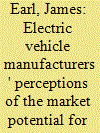|
|
|
Sort Order |
|
|
|
Items / Page
|
|
|
|
|
|
|
| Srl | Item |
| 1 |
ID:
147444


|
|
|
|
|
| Summary/Abstract |
This paper derives a NEG-style model that outlines several spatial spillover channels and examines the effects of proximities to spatially distributed factor supply and market demand on Chinese urban economies. A panel dataset of 283 prefecture or higher-level cities from 2003–2013 is used for the empirical analysis. The estimation shows that proximities to government expenditure on science and technology, to professionals in science and technology, and to the domestic and foreign markets all contribute to urban manufacturing growth, while concentrations of specialized labor force and producer services in neighboring cities have negative effects. The spatial effects of factor proximities and market potentials differ in China's three regions. Surprisingly, cities in the central region have the most significant gain from spillovers of factor supply, and cities in the eastern and western regions benefit substantially from the domestic and foreign markets. Policy implications are derived from the findings.
|
|
|
|
|
|
|
|
|
|
|
|
|
|
|
|
| 2 |
ID:
166474


|
|
|
|
|
| Summary/Abstract |
While there is extensive research on the technical potential of electric vehicles (EVs) to provide electricity system flexibility, no work has sought to understand how EV manufacturers see their role in this transition. Here we present an interview study with 11 EV manufacturers active in the UK, determining their perceptions on the market potential for demand-side flexibility using EVs. Findings indicate manufacturers view significant potential in this market, but believe time is needed (i.e. in the 2020s) for the EV market to develop before there is enough system/consumer demand for flexibility using EVs. They believe better price signals are needed, and prefer a consumer-led approach (rather than, for example, mandatory smart charging). Most manufacturers recognise they have a role in making flexibility a viable offering, but for it to succeed it needs coordination with other players, notably energy suppliers, aggregators, network operators and consumers. Governments should have a role in encouraging and brokering such partnerships. There was little evidence of concern that network constraints resulting from multiple EVs charging on the same circuit could act as a brake on sales. We identify a risk that EV growth could outpace available infrastructure and flexibility market mechanisms, leading to grid management challenges.
|
|
|
|
|
|
|
|
|
|
|
|
|
|
|
|
| 3 |
ID:
116520


|
|
|
|
|
| Publication |
2012.
|
| Summary/Abstract |
This paper investigates the spatial structure of the provincial economic growth and the spatial spillover in China from 1998 to 2008. First, we apply Moran's index to detect the positive spatial autocorrelations across the provinces of China. Second, we build a new economic geography model and the role of market potential in promoting regional income growth is highlighted. Third, two measures of market potential are constructed and a spatial error model is adopted to obtain the estimations, considering spatial autocorrelation. Controlling for major inputs, such as labor, capital, and human capital, the market potential continues to promote substantial regional growth. On average, an increase of 10 percentage points in the market potential increases the regional GDP per capita growth by 3-5 percentage points.
|
|
|
|
|
|
|
|
|
|
|
|
|
|
|
|
| 4 |
ID:
182721


|
|
|
|
|
| Summary/Abstract |
Using high-speed railway (HSR) construction in China as a quasi-experiment, this paper contributes to the understanding of how transportation infrastructure affects entrepreneurship. On the basis of a difference-in-difference approach, we find that access to an HSR connection leads to an increase in entrepreneurship by approximately 3.5 percentage points (35% of the mean). Mechanism exploration suggests that market potential is the main channel that HSR encourages entrepreneurial activities, which is realized by accelerated information sharing and face-to-face interactions. And the effect is bigger for high-educated families, wealthy families and in large cities.
|
|
|
|
|
|
|
|
|
|
|
|
|
|
|
|
|
|
|
|
|